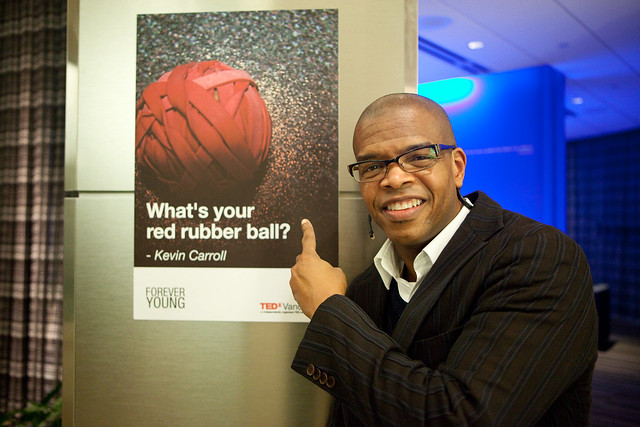First, let me say that it was going to be so perfect, so relaxing. Shannon and I had prepared our presentation Teaching in Beta: How Video Killed the Red Pen, and we were going down to Columbus early so we would be fresh and ready to deliver at the Learn 21 Conference the next morning. This was our agenda:
- Leave school
- Go directly to Starbucks (Frappucinos! Yes!)
- Drive ninety minutes to Columbus
- Check into the hotel
- Go to a nice place for dinner
- Rehearse the presentation
When the car behind us on the highway slammed into us and pushed us into a water-filled ditch, we realized that everything would not be going according to our agenda. Luckily, nobody was hurt, and we live in the age of cell phones, so we were able to get help. Lots of help. Three hours, one policeman, one firetruck, one EMS attendant, and two tow trucks worth of help. This wonderful team made sure we weren’t in danger, reassured us, investigated the situation, protected us from the cars whizzing by on the highway, and finally pulled us out of the ditch. It took three hours.
 |
| Getting in and out of the car was fun. It was even more fun for the tow truck guy. Photo credit: Shannon Conley-Kurjian |
Flash forward to the next morning: We arrived at Ohio State University’s Student Union with plenty of time to spare, and we started to boot up our devices and plug them into the wireless connection. Between the two of us, we had brought a Dell, a Chromebook, a Macbook, two iPads, and two iPhones, and NONE of them would connect. I started sweating as I texted Christina, our tech integration coach, to leave her session and come help us, which she promptly did. Of course she did the same thing I had been doing for ten minutes, but it worked for her. Grrrr.
We plugged the working laptop into the thingy with the cord (sorry for the technical jargon), did a test run, and realized that the sound wasn’t working. Our room started filling up as flop sweat gathered on my upper lip. Shannon found some help, and once again a team came to our rescue.
After all that, the presentation went really well. Click here to see our slides about Teaching in Beta.
I started this post with the intention of reviewing the sessions I saw at Learn 21, but now I realize that those sessions weren’t really the focus of what I learned at Learn 21. Don’t get me wrong; I’m still going to write a post about Gamification, but that will be for another time. The most important thing I learned from my two days is the importance of a team. Shannon, Christina, and I are a team, as you can see from reading our previous posts. Shannon and I supported each other not only through planning the presentation, but also during the car accident and its after effects. We found a way to laugh at ourselves and our situation when we had to stop to buy duct tape to keep the back end of the car together on the way home.
We assured each other (and the other driver) that we were very, very lucky. Christina offered to pick us up off the highway and stayed in touch with us when we said we’d stick with the car. I’m not going to mention the fact that she was eating a giant cream puff from Schmidt’s while we were standing in the rain by the side of the highway. Oh wait. . .
When we had trouble connecting at the conference, Christina was the first one there to help, and her calm demeanor kept me from gouging out my brain.
 |
| Classy, right? |
We assured each other (and the other driver) that we were very, very lucky. Christina offered to pick us up off the highway and stayed in touch with us when we said we’d stick with the car. I’m not going to mention the fact that she was eating a giant cream puff from Schmidt’s while we were standing in the rain by the side of the highway. Oh wait. . .
 |
| I guess I did just mention it. Photo credit: Christina Hamman. Ahem. |
When we had trouble connecting at the conference, Christina was the first one there to help, and her calm demeanor kept me from gouging out my brain.
Danielle Tymitz from Learn 21 hooked us up with fabulous chair massages, which honestly kept me from having to go to a doctor after the accident. All that tension melted away as the massotherapist kneaded my neck and shoulders.
The teams of people who took care of us before, during, and after the conference (our techie sound-guys, the tow truck drivers, Medina people, Learn 21 people) turned what could have been a frightening situation into a lesson on support.
We all need a team. We need to work together to move forward and sometimes just to hold on to each other to keep from slipping backward. How many times have you decided you were going to give up on a project/student/lesson/administrator and someone talked you off the ledge? Living in Beta means taking risks and being uncomfortable. I feel a lot better knowing that I can take risks in my teaching when I have a team at my back. I’d like to thank all the members of the teams who helped us to realize this at Learn 21.
Like what you read? Follow me on Twitter @itibrout!





 Kevin Carroll, founder of Kevin Carroll Katalyst, pointing to what got him started[/caption]
Kevin Carroll, founder of Kevin Carroll Katalyst, pointing to what got him started[/caption] She looks so poised and professional here. What happened?[/caption]
She looks so poised and professional here. What happened?[/caption] Centennial Park[/caption]
Centennial Park[/caption]

